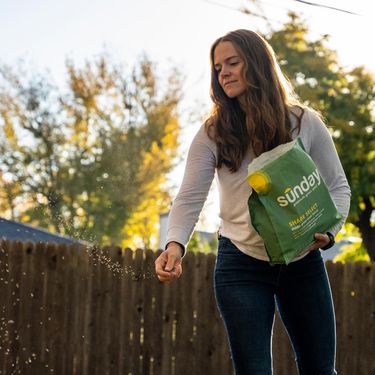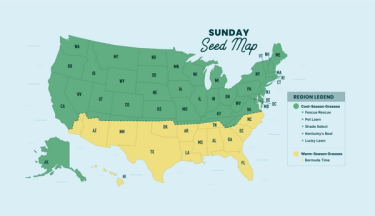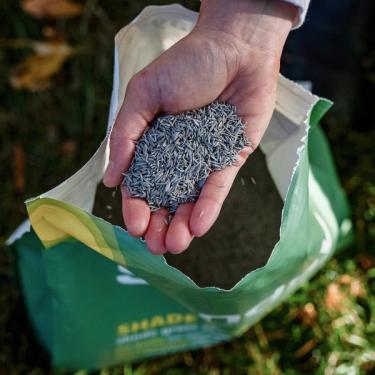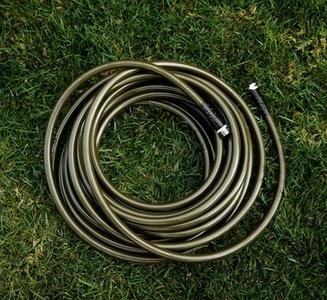Summer is tough on lawns. The combination of heat, low rainfall, foot traffic, and pet spots often leaves behind bare or thin patches that are magnets for weeds. Fall is the ideal time to repair this damage and build a thicker, more resilient lawn by seeding.
Why plant grass seed in the fall?
Planting grass in fall gives new grass an advantage that other seasons can't match.
Repair summer damage: Summer heat, foot traffic, and pet spots are harsh on lawns. Seeding directly into those bare and thinning areas introduces healthy new grass before winter arrives.
Prevent spring weeds: A thick, dense lawn is the best natural defense against weeds. New grass outcompetes weeds for space, light, and nutrients, reducing your need for weed killers.
Ideal growing conditions: Fall provides the perfect environment for new seeds to grow. Soil is still warm from the summer, while cooler air temperatures and more consistent moisture reduce stress on young seedlings.
It works with fertilizer: A thicker lawn with a stronger root system makes the most of any nutrient application. More grass means more efficient uptake of the fall fertilizer you apply.

When to plant fall grass seed
For cool-season grasses like fescue, ryegrass, and bluegrass, the best time to seed is 6-8 weeks before your first hard frost. This is typically from mid-August through September, when soil temperatures are between 55°F and 75°F.
- Northernmost Regions: Mid-August to early September
- Transitional Northern Regions: Late August to mid-September
If you have a warm-season grass like Bermuda or zoysia, skip fall seeding. The best time to plant warm-season grass is in late spring to early summer.

Sunday Tip:
Want to know your exact seeding window? Head to your Sunday My Plan page to find yours!
How to plant grass seed in the fall
Follow these five steps for the best results.
Remove weeds
About a week before seeding, remove existing weeds by hand-pulling or spot-treating with Dandelion Doom.
For bare spots, gently rake the soil to loosen the top layer. This helps the new seeds make direct contact with the soil, which is critical for germination.
Select the right seed
Choose a high-quality grass seed that matches your lawn's conditions, considering your climate, sun exposure, and how you use your lawn.
Fescue blends are excellent for shady or high-traffic areas, while Kentucky Bluegrass offers a classic dark-green color.
Sunday Tip:
Still unsure? Use Sunday's Seed Finder Tool to find the right Sunday seed for your yard!
All Sunday Grass Seed is A-LIST approved - meaning it's been rigorously tested for quality and sustainability, including lower water, nutrient, and pesticide needs. One of the hardest seeds to find on the market, delivered straight to your door!

Mow low and clear debris
Cut your existing lawn shorter than usual (to about 1.5-2 inches) and bag the clippings. This allows seeds and sunlight to reach the soil surface easily.
Apply grass seeds
Spread the seed evenly across your lawn according to the rates on the product label.
Using a broadcast spreader for overseeding large areas ensures even coverage. For bare spot repair, a handheld spreader or spreading by hand is effective.
Water to germination
New seed requires consistent moisture. Water the seeded areas lightly once or twice a day to keep the top inch of soil moist until the new grass begins to sprout. Germination can take anywhere from 5 to 21 days, depending on the seed type.
After grass sprouts above ground, gradually water less often but for longer periods.
Sunday Tip:
Different fall grass seed types germinate at different speeds:
Perennial ryegrass: 3-7 days
Tall fescue: 6-12 days
Kentucky bluegrass: 14-21 days
Get your free lawn analysis
Sunday's science-backed, pet-friendly lawn plan is tailored to your yard’s soil, climate, and grass type. Get growing today.
What if I miss fall grass seeding?
If you miss the ideal fall window, you still have options:
- Try "frost" or dormant seeding. In northern climates, you can apply seed in late fall or early winter after temperatures are too cold for germination. The seeds will lie dormant and sprout first thing in the spring.
- Plan ahead for spring. Use the fall to prepare your soil by removing weeds and adding organic amendments (like mulched leaves and grass clippings!). This will give you a head start for a successful, though slightly more challenging, spring seeding.
Cited sources
Consider dormant seeding your lawn this fall. University of Minnesota Extension.
Fall Into Your Lawn: Establishing Cool-season Turfgrasses. Virginia Tech Cooperative Extension.
Lawn Care: The Easiest Steps to an Attractive Environmental Asset. Cornell University Extension.
Lawn Management Through the Seasons. Penn State University Extension.


















